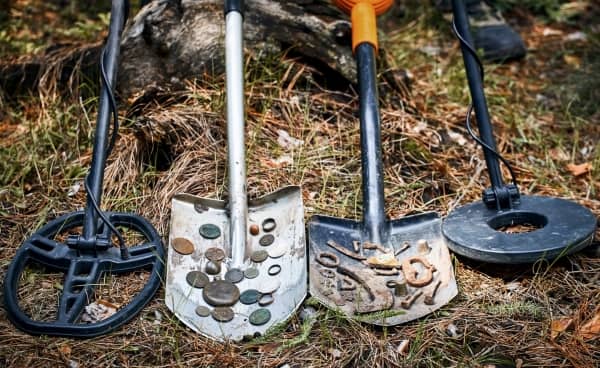Magnetism is astounding; it’s like magic. But have you ever wondered why some materials respond to magnets whilst some don’t? At Collins Recycling, we encounter tons of metals, and we understand which are magnetic metals and which are not. We also know the concept behind this attraction. That’s why we’re sharing this knowledge with you today. If you’re wondering, “Are all metals magnetic?” this blog is for you.
What Metals Are Magnetic?
Most people know that magnets attract metals, but the reality is not all metals are attracted to magnets. Those called “ferromagnetic” metals have the strongest magnetic attraction. The most commonly known ferromagnetic metals are:
- Iron
- Nickel
- Cobalt
- Alloys with iron, nickel, and cobalt
- Permalloy
- Some types of steel, such as EN C15D, which has 98.81%-99.26% iron
- Some types of stainless steel
- Alnico (contains iron, nickel, copper, aluminium, titanium, and cobalt)
- Wairauite (contains iron and cobalt)
- Awaruite (contains iron and nickel)
- Chromindur (with cobalt, iron, and chromium)
- Ferrite
Other lesser-known ferromagnetic metals are rare earth metals, such as:
- Gadolinium
- Samarium
- Neodymium
Some metals that are ferrimagnetic (note that this has an “I”, not an “O”) and paramagnetic are also magnetic but have a much weaker attraction than ferromagnetic ones.
Examples of paramagnetic metals are:
- Platinum
- Aluminium
- Magnesium
- Caesium
- Lithium
- Molybdenum
- Tungsten
- Sodium
- Uranium
As for ferrimagnetic metals, one example that belongs in this category is magnetite. Did you know that some metals like silver, gold, lead, and copper are diamagnetic? That’s because they repel magnets, although the effect is not that visible. Copper is not magnetic, but it does interact with magnets. This attribute is used to help generate electricity.
Why are Some Metals Magnetic?
You’re probably wondering why some metals are magnetic, and others are not. To understand the answer to this question, you have to know how magnetism works. As electrons move in an atom, a small magnetic field is produced. Ordinarily, this magnetic field is cancelled due to other electrons moving with their opposing magnetic fields.
Magnetism occurs when there is no opposing side. When you apply a magnetic field to some materials, the other electrons start spinning to align with one another. This motion creates a net field in and around the whole material. That’s what happens with iron and other magnetic metals. Instead of cancelling out each other’s magnetic fields, their electrons work together and join to create a much stronger field.
In certain metals, this alignment of electrons disappears upon the removal of the magnetic field. In others, however, it remains even when you remove the field.
Magnets have positive and negative poles, also known as the north and south poles. Opposite poles (N+S) attract while matching poles (N+N or S+S) repel each other.
So, when we’re talking about ferromagnetic materials, they attract magnets due to their electrons spinning and aligning easily. They can retain this alignment without needing an external magnetic field.
Alloys made from ferromagnetic metals are also attracted to magnets, such as steel and stainless steel. Steel is derived from iron, so it displays ferromagnetic properties, meaning most steel types are attracted to magnets. Stainless steel can be magnetic, although some types are not. Alloy steel is converted to stainless steel if it contains 10.5% chromium or more. If the stainless steel is classed as ferritic or martensitic, it is magnetic because it contains iron.
In the example above, alnico contains cobalt and iron, among others, and so does wairauite. These metals and other alloys with ferromagnetic metals will have magnetic properties transferred to them.
Ferrimagnetic metals, on the other hand, have an ionic compound with two lattices of material that come with opposing magnetic poles. However, these lattices are not entirely balanced, which then results in a net magnetisation. An example here is magnetite, which was once considered a ferromagnetic metal. However, ferrimagnetic materials are generally leaning more on ceramics and not metal.
Diamagnetic metals like gold, copper, mercury, and lead repel magnets, usually weakly. They are classed so because their magnetic moments oppose the magnetic field rather than enhance it.
Does This Mean Metal Detectors Cannot Detect Non-Magnetic Metals?
Metal detectors will detect any metal, whether or not they are magnetic. So, if you have silver, copper, aluminium, or gold, it will be detected. Both paramagnetic and diamagnetic metals are not magnetic, but they still interact with magnets. Unfortunately, the naked eye cannot see this interaction. For this very reason, you can rely on metal detectors to locate non-magnetic materials.
Are Magnetic Metals Stronger and Pricier?
Some sources claim that magnetic materials are more durable and come at a heftier price. In reality, it is not the case. The magnetic property of any metal does not dictate the robustness of the material, as well as its cost.
Think about it; steel is highly magnetic, but titanium easily beats it when it comes to tensile strength. Titanium has the highest tensile strength to density ratio. It is pound-for-pound stronger than tungsten, a naturally occurring metal with the highest tensile strength. Titanium, as stated above, is not ferromagnetic, just like tungsten.
Gold is among the softest metals we know. It has been chemically or physically modified to reduce its hardness. Gold, lead, and other similar materials are often known as “soft” magnets and are strengthened using steel or iron.
Attracting magnets, an intrinsic property of the material, does not affect the pricing of the metal. Therefore, there is no extra cost gained if you have magnetic ones.
Uses of Magnetic Metals
Metals can be recycled to create new products, such as:
- Compasses
- Part of a hard drive or other the magnetic data storage systems
- Speakers
- Microphones
- Toys
- Electric guitar picks
- Credit or debit card magnetic strips
- Electric motors
- Magnetic Resonance Imaging (MRI)
You may want to group them to make collection easier when selling unwanted metals. Nevertheless, we can pick up your scrap metals and recycle them to make valuable products without the need to mine new materials. Contact Collins Recycling, and we can sort magnetic and non-magnetic metals for you.









